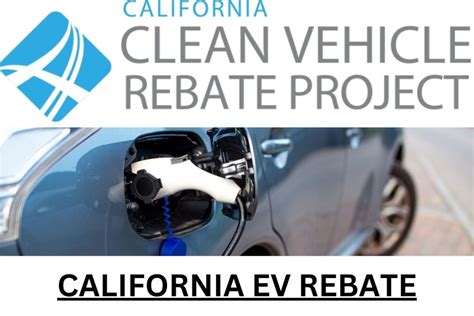The Clean Vehicle Rebate Project (CVRP) is on a mission to transform the landscape of transportation toward a greener, more sustainable future. As the world grapples with the pressing challenges posed by climate change and pollution, initiatives like the CVRP are not just helpful; they are crucial. With the year 2025 around the corner, the program is gearing up for a significant expansion, aimed at making electric vehicle (EV) adoption more accessible and widespread.
The Vision Behind the Clean Vehicle Rebate Project
Established in California, the CVRP seeks to encourage the purchase and lease of zero-emission vehicles by providing rebates to consumers. Under this innovative scheme, financial incentives help offset the higher upfront cost of electric vehicles (EVs), making them more appealing to a broader audience. Thanks to consistent rebates, California has seen rising adoption rates of EVs, setting an example that other states might follow.
The objective is clear: to reduce greenhouse gas emissions, improve air quality, and ultimately contribute to a healthier planet. The significance of such initiatives cannot be overstated, especially considering transportation is one of the largest sources of greenhouse gases in the United States.
Enhancements for 2025
As 2025 approaches, there are exciting developments in the pipeline for the CVRP. State agencies and stakeholders have recognized the need to scale their efforts. Some enhancements include:
- Increased Rebates: Initial proposals suggest augmenting rebate amounts, allowing consumers to benefit even more when purchasing an EV. This will make the transition from gasoline vehicles to electric ones more financially viable.
- Wider Eligibility: The CVRP is looking to broaden its scope to include a more diverse range of vehicles, including trucks and other commercial vehicles, which could lead to significant reductions in business-related emissions.
- Streamlined Application Process: As more consumers engage with the program, improving the application process will be essential. Efforts to simplify and accelerate applications will help ensure a smoother experience for potential EV buyers.
- Outreach and Education: The project aims to implement strong outreach initiatives to inform communities about the benefits of going electric, addressing common misconceptions and raising awareness about the financial and environmental incentives involved.
Impacts of the Clean Vehicle Rebate Project
The potential impact of the CVRP expansion goes beyond just numbers and statistics. By providing incentives, the program empowers individuals and businesses to make choices that align with environmental sustainability. Here are some notable impacts:
- Reduction in Greenhouse Gas Emissions: More EVs on the road directly translates to fewer emissions, contributing to the fight against climate change.
- Improved Air Quality: Transitioning to electric vehicles aids in reducing air pollutants, leading to healthier communities and improved public health.
- Economic Growth: The rise of the electric vehicle market can stimulate job creation in various sectors, including manufacturing, maintenance, charging infrastructure, and more.
- Technological Advancement: As demand for EVs increases, technology continues to evolve, leading to better battery life, quicker charging times, and more sustainable materials in vehicle production.
Community Engagement and Support
Successful implementation of the CVRP requires robust community engagement. Local governments, businesses, and non-profits play vital roles in supporting and promoting the initiative. Together, they can help raise awareness, provide additional incentives, and create a conducive environment for EV adoption.
Support from public organizations and NGOs helps strengthen the infrastructure necessary for a successful EV transition. Investing in charging networks, for example, decreases range anxiety, making electric vehicle ownership more appealing.
Conclusion
The Clean Vehicle Rebate Project 2025 represents a significant step forward in redefining how we think about transportation. As the program gears up to enhance its offerings, the focus remains on making electric vehicles accessible, sustainable, and appealing to a wider audience. The road to a greener future is clear, but it requires the collective effort and commitment of communities, governments, and industries to drive meaningful change. By empowering consumers through effective rebates and robust engagement, the CVRP is paving the way for a cleaner, healthier planet for future generations.
FAQs
What is the Clean Vehicle Rebate Project?
The Clean Vehicle Rebate Project (CVRP) is a California program designed to incentivize the purchase or lease of zero-emission vehicles by offering financial rebates to consumers.
Who is eligible for the rebate?
Eligibility typically includes residents of California who purchase or lease qualifying zero-emission vehicles. Specific guidelines can vary, so it’s essential to check the program’s website for detailed information.
How much is the rebate?
The rebate amount can vary based on vehicle type and battery capacity, as well as other criteria set by the program. Initial proposals for 2025 suggest increasing these amounts to further incentivize purchases.
How do I apply for the rebate?
Applications for the rebate can typically be completed online through the CVRP website. The process will be streamlined to make it easier for consumers as the program evolves for 2025.
What types of vehicles qualify for the rebate?
Currently, the rebate is available for various zero-emission vehicles, including electric cars and certain plug-in hybrids. The program aims to broaden its eligibility to include more vehicle types, such as commercial trucks.
Can businesses benefit from the CVRP?
Yes, businesses that purchase or lease qualifying zero-emission vehicles can also receive rebates, contributing to lower emissions in commercial transportation.
Download Clean Vehicle Rebate Project 2025
